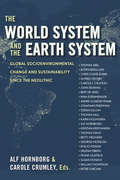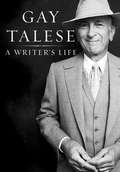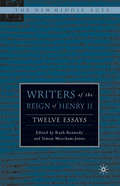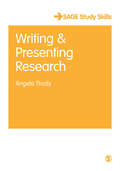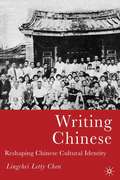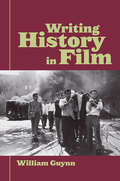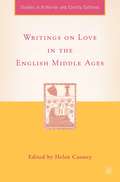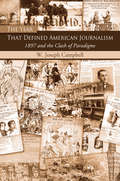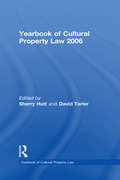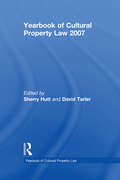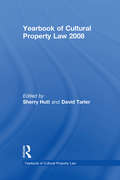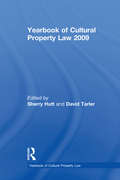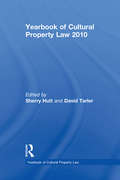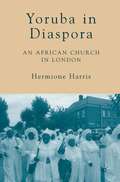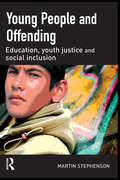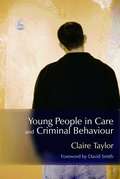- Table View
- List View
The World System and the Earth System: Global Socioenvironmental Change and Sustainability Since the Neolithic
by Alf Hornborg Carole L. CrumleyIn this benchmark volume top scholars come together to present state-of-the-art research and pursue a more rigorous framework for understanding and studying the linkages between social and ecological systems. Contributors from a wide spectrum of disciplines, including archaeology, anthropology, geography, ecology, palaeo-science, geology, sociology, and history, present and assess both the evolution of our thinking and current, state-of-the-art theory and research. Covering ancient through modern periods, they discuss the complex ways in which human culture, economy, and demographics interact with ecology and climate change. The World System and the Earth System is critical reading for all scholars and students working at the interface of nature and society.Contributors: Thomas Abel, Björn Berglund, Chris Chase-Dunn, Alfred Crosby, Carole L. Crumley, John Dearing, Bert de Vries, Nina Eisenmenger, Andre Gunder Frank, Jonathan Friedman, Stefan Giljum, Thomas Hall, Karin Holmgren, Alf Hornborg, Kristian Kristiansen, Thomas Malm, Daniel Mandell, Betty Meggers, George Modelski, Emilio Moran, Helena Öberg, Frank Oldfield, Susan Stonich, William Thompson, Peter Turchin.
A Writer's Life
by Gay TaleseHow has Gay Talese found his subjects? How has he gotten them onto the page? What drives him to write? These are some of the questions at the heart of the narrative that combines memory, reflection, explanation and a satisfying obsession. I his trademark prose - precise, beautifully crafted, elegant - Talese traces the paths his passionate interests have made through his life and writing. He talks about first becoming absorbed in issues of race as a student in Alabama, about covering the civil rights struggle and about a recent interracial wedding in Selma. He reflects on the changing American sexual mores he has written about over the last 50 years, and gives an incisive examination of the lives of Lorena and John Bobbitt. He talks about his legendary Esquire profile of Frank Sinatra - judged by the magazine to be the finest in its long history - and about the ordinary men and women whose stories led to some of his most memorable work. And as he delves into the life of a young female Chinese soccer player, we see his consuming interest in the world in its latest manifestation. In these and other recollections and stories, he gives us a fascinating picture of both the serendipity and meticulousness involved in getting a story, and getting it right.Candid, humorous, deeply impassioned - a dazzling book about the nature of writing in one man's life, and of writing itself.
Writers of the Reign of Henry II: Twelve Essays (The New Middle Ages)
by R. Kennedy S. Meecham-JonesThis collection of work studies the often neglected writers of the second half of the twelfth century in England. At this time three languages competed for recognition and prestige and carved out their own spaces, while an English-speaking populace was ruled by a French-speaking aristocracy and administered by a Latin-speaking and writing clergy.
Writing and Presenting Research (SAGE Study Skills Series (PDF))
by Professor Angela ThodyThis accessible and wide-ranging book is an invaluable introductory guide through the choices to be made when deciding how to report research. Writing and Presenting Research covers research written as theses and dissertations; chapters, books, reports and articles in academic, professional or general media such as newspapers; and also reviews the options for presenting research orally as lectures, keynotes, conference papers and even TV game shows. These forms of reporting research have well-established conventions for their formats, but they also have growing numbers of alternative possibilities. This has generated debate about what is, or is not, acceptable, and the aim of this book is to make this debate more manageable for those wanting to assess which of the conventional or alternative possibilities on offer is most appropriate for reporting their current research. Arranged in easily followed sections enlivened with checklists, style variations, examples and reflection points, Writing and Presenting Research has relevance to the social sciences, arts, humanities, natural and applied sciences and law and is an invaluable reference tool for new and experienced researchers alike. SAGE Study Skills are essential study guides for students of all levels. From how to write great essays and succeeding at university, to writing your undergraduate dissertation and doing postgraduate research, SAGE Study Skills help you get the best from your time at university. Visit the SAGE Study Skills website for tips, quizzes and videos on study success!
Writing and Presenting Research (SAGE Study Skills Series (PDF))
by Professor Angela ThodyThis accessible and wide-ranging book is an invaluable introductory guide through the choices to be made when deciding how to report research. Writing and Presenting Research covers research written as theses and dissertations; chapters, books, reports and articles in academic, professional or general media such as newspapers; and also reviews the options for presenting research orally as lectures, keynotes, conference papers and even TV game shows. These forms of reporting research have well-established conventions for their formats, but they also have growing numbers of alternative possibilities. This has generated debate about what is, or is not, acceptable, and the aim of this book is to make this debate more manageable for those wanting to assess which of the conventional or alternative possibilities on offer is most appropriate for reporting their current research. Arranged in easily followed sections enlivened with checklists, style variations, examples and reflection points, Writing and Presenting Research has relevance to the social sciences, arts, humanities, natural and applied sciences and law and is an invaluable reference tool for new and experienced researchers alike. SAGE Study Skills are essential study guides for students of all levels. From how to write great essays and succeeding at university, to writing your undergraduate dissertation and doing postgraduate research, SAGE Study Skills help you get the best from your time at university. Visit the SAGE Study Skills website for tips, quizzes and videos on study success!
Writing Chinese: Reshaping Chinese Cultural Identity
by L. ChenThis is a comparative study of the politics of Chinese cultural identity facing China, Taiwan, Hong Kong, the US-Chinese, and the Chinese diaspora in the West. The author challenges current discussions of hybridity and nationalism by contrasting the experiences of Taiwan, Hong Kong and US-Chinese with those of China and the Chinese diaspora.
Writing History in Film
by William GuynnHistorical film has been an important genre since the earliest silent films. The French Revolution, the American Civil War, the conquest of the New World, World War II--all have been repeatedly represented in film. But how do we distinguish between fictionalized spectacle and authentic historical representation? Writing History in Film sets out the narratological, semiological, rhetorical, and philosophical bases for understanding how film can function as a form of historical interpretation and representation. With case studies and an interdisciplinary approach, William Guynn examines the key issues facing film students and scholars, historians, and anyone interested in how we see our historical past.
Writing History in Film
by William GuynnHistorical film has been an important genre since the earliest silent films. The French Revolution, the American Civil War, the conquest of the New World, World War II--all have been repeatedly represented in film. But how do we distinguish between fictionalized spectacle and authentic historical representation? Writing History in Film sets out the narratological, semiological, rhetorical, and philosophical bases for understanding how film can function as a form of historical interpretation and representation. With case studies and an interdisciplinary approach, William Guynn examines the key issues facing film students and scholars, historians, and anyone interested in how we see our historical past.
Writings on Love in the English Middle Ages (Arthurian and Courtly Cultures)
by H. CooneyThis is a set of essays from many of the leading scholars in the world of medieval studies, which addresses a wide diversity of texts and genres and their diverse perspectives on love. Attention is given to interaction between English writings and putative continental and international influences, with particular emphasis on the works of Chaucer.
The Year That Defined American Journalism: 1897 and the Clash of Paradigms
by W. Joseph CampbellThe Year that Defined American Journalism explores the succession of remarkable and decisive moments in American journalism during 1897 – a year of significant transition that helped redefine the profession and shape its modern contours. This defining year featured a momentous clash of paradigms pitting the activism of William Randolph Hearst's participatory 'journalism of action' against the detached, fact-based antithesis of activist journalism, as represented by Adolph Ochs of the New York Times, and an eccentric experiment in literary journalism pursued by Lincoln Steffens at the New York Commercial-Advertiser. Resolution of the three-sided clash of paradigms would take years and result ultimately in the ascendancy of the Times' counter-activist model, which remains the defining standard for mainstream American journalism. The Year That Defined American Journalism introduces the year-study methodology to mass communications research and enriches our understanding of a pivotal moment in media history.
The Year That Defined American Journalism: 1897 and the Clash of Paradigms
by W. Joseph CampbellThe Year that Defined American Journalism explores the succession of remarkable and decisive moments in American journalism during 1897 – a year of significant transition that helped redefine the profession and shape its modern contours. This defining year featured a momentous clash of paradigms pitting the activism of William Randolph Hearst's participatory 'journalism of action' against the detached, fact-based antithesis of activist journalism, as represented by Adolph Ochs of the New York Times, and an eccentric experiment in literary journalism pursued by Lincoln Steffens at the New York Commercial-Advertiser. Resolution of the three-sided clash of paradigms would take years and result ultimately in the ascendancy of the Times' counter-activist model, which remains the defining standard for mainstream American journalism. The Year That Defined American Journalism introduces the year-study methodology to mass communications research and enriches our understanding of a pivotal moment in media history.
Yearbook of Cultural Property Law 2006 (Yearbook of Cultural Property Law)
by Sherry Hutt David TarlerThe Yearbooks of Cultural Property Law provide the key, up-to-date information and analyses that keep heritage professionals, lawyers, and land managers abreast of current legal practice, including summaries of notable court cases, settlements and other dispositions, legislation, government regulations, policies and agency decisions. Interviews with key figures, refereed research articles, think pieces, and a substantial resources section round out each volume. Thoughtful analyses and useful information from leading practitioners in the diverse field of cultural property law will assist government land managers, state, tribal and museum officials, attorneys, anthropologists, archaeologists, public historians, and others to better preserve, protect and manage cultural property in domestic and international venues. In addition to eight practice-area sections (federal land management; state and local; tribes, tribal lands, and Indian arts; marine environment; museums; art market; international; enforcement actions), the 2009 volume features an interview with an important figure in the field and original articles on new ICOMOS rules on dispute resolution, Section 47 of the Internal Revenue Code, risk and fair market value of antiquities, the visual artists rights act, and religious free exercise and historic preservation. All royalties are donated to the Lawyer’s Committee on Cultural Heritage Preservation.
Yearbook of Cultural Property Law 2006 (Yearbook of Cultural Property Law)
by Sherry Hutt and David TarlerThe Yearbooks of Cultural Property Law provide the key, up-to-date information and analyses that keep heritage professionals, lawyers, and land managers abreast of current legal practice, including summaries of notable court cases, settlements and other dispositions, legislation, government regulations, policies and agency decisions. Interviews with key figures, refereed research articles, think pieces, and a substantial resources section round out each volume. Thoughtful analyses and useful information from leading practitioners in the diverse field of cultural property law will assist government land managers, state, tribal and museum officials, attorneys, anthropologists, archaeologists, public historians, and others to better preserve, protect and manage cultural property in domestic and international venues. In addition to eight practice-area sections (federal land management; state and local; tribes, tribal lands, and Indian arts; marine environment; museums; art market; international; enforcement actions), the 2009 volume features an interview with an important figure in the field and original articles on new ICOMOS rules on dispute resolution, Section 47 of the Internal Revenue Code, risk and fair market value of antiquities, the visual artists rights act, and religious free exercise and historic preservation. All royalties are donated to the Lawyer’s Committee on Cultural Heritage Preservation.
Yearbook of Cultural Property Law 2007 (Yearbook of Cultural Property Law)
by Sherry Hutt David TarlerThe Yearbooks of Cultural Property Law provide the key, up-to-date information and analyses that keep heritage professionals, lawyers, and land managers abreast of current legal practice, including summaries of notable court cases, settlements and other dispositions, legislation, government regulations, policies and agency decisions. Interviews with key figures, refereed research articles, think pieces, and a substantial resources section round out each volume. Thoughtful analyses and useful information from leading practitioners in the diverse field of cultural property law will assist government land managers, state, tribal and museum officials, attorneys, anthropologists, archaeologists, public historians, and others to better preserve, protect and manage cultural property in domestic and international venues. In addition to eight practice-area sections (federal land management; state and local; tribes, tribal lands, and Indian arts; marine environment; museums; art market; international; enforcement actions), the 2009 volume features an interview with an important figure in the field and original articles on new ICOMOS rules on dispute resolution, Section 47 of the Internal Revenue Code, risk and fair market value of antiquities, the visual artists rights act, and religious free exercise and historic preservation. All royalties are donated to the Lawyer’s Committee on Cultural Heritage Preservation.
Yearbook of Cultural Property Law 2007 (Yearbook of Cultural Property Law)
by Sherry Hutt and David TarlerThe Yearbooks of Cultural Property Law provide the key, up-to-date information and analyses that keep heritage professionals, lawyers, and land managers abreast of current legal practice, including summaries of notable court cases, settlements and other dispositions, legislation, government regulations, policies and agency decisions. Interviews with key figures, refereed research articles, think pieces, and a substantial resources section round out each volume. Thoughtful analyses and useful information from leading practitioners in the diverse field of cultural property law will assist government land managers, state, tribal and museum officials, attorneys, anthropologists, archaeologists, public historians, and others to better preserve, protect and manage cultural property in domestic and international venues. In addition to eight practice-area sections (federal land management; state and local; tribes, tribal lands, and Indian arts; marine environment; museums; art market; international; enforcement actions), the 2009 volume features an interview with an important figure in the field and original articles on new ICOMOS rules on dispute resolution, Section 47 of the Internal Revenue Code, risk and fair market value of antiquities, the visual artists rights act, and religious free exercise and historic preservation. All royalties are donated to the Lawyer’s Committee on Cultural Heritage Preservation.
Yearbook of Cultural Property Law 2008 (Yearbook of Cultural Property Law)
by Sherry Hutt David TarlerThe Yearbooks of Cultural Property Law provide the key, up-to-date information and analyses that keep heritage professionals, lawyers, and land managers abreast of current legal practice, including summaries of notable court cases, settlements and other dispositions, legislation, government regulations, policies and agency decisions. Interviews with key figures, refereed research articles, think pieces, and a substantial resources section round out each volume. Thoughtful analyses and useful information from leading practitioners in the diverse field of cultural property law will assist government land managers, state, tribal and museum officials, attorneys, anthropologists, archaeologists, public historians, and others to better preserve, protect and manage cultural property in domestic and international venues. In addition to eight practice-area sections (federal land management; state and local; tribes, tribal lands, and Indian arts; marine environment; museums; art market; international; enforcement actions), the 2009 volume features an interview with an important figure in the field and original articles on new ICOMOS rules on dispute resolution, Section 47 of the Internal Revenue Code, risk and fair market value of antiquities, the visual artists rights act, and religious free exercise and historic preservation. All royalties are donated to the Lawyer’s Committee on Cultural Heritage Preservation.
Yearbook of Cultural Property Law 2008 (Yearbook of Cultural Property Law)
by Sherry Hutt and David TarlerThe Yearbooks of Cultural Property Law provide the key, up-to-date information and analyses that keep heritage professionals, lawyers, and land managers abreast of current legal practice, including summaries of notable court cases, settlements and other dispositions, legislation, government regulations, policies and agency decisions. Interviews with key figures, refereed research articles, think pieces, and a substantial resources section round out each volume. Thoughtful analyses and useful information from leading practitioners in the diverse field of cultural property law will assist government land managers, state, tribal and museum officials, attorneys, anthropologists, archaeologists, public historians, and others to better preserve, protect and manage cultural property in domestic and international venues. In addition to eight practice-area sections (federal land management; state and local; tribes, tribal lands, and Indian arts; marine environment; museums; art market; international; enforcement actions), the 2009 volume features an interview with an important figure in the field and original articles on new ICOMOS rules on dispute resolution, Section 47 of the Internal Revenue Code, risk and fair market value of antiquities, the visual artists rights act, and religious free exercise and historic preservation. All royalties are donated to the Lawyer’s Committee on Cultural Heritage Preservation.
Yearbook of Cultural Property Law 2009 (Yearbook of Cultural Property Law)
by Sherry Hutt David TarlerThe Yearbooks of Cultural Property Law provide the key, up-to-date information and analyses that keep heritage professionals, lawyers, and land managers abreast of current legal practice, including summaries of notable court cases, settlements and other dispositions, legislation, government regulations, policies and agency decisions. Interviews with key figures, refereed research articles, think pieces, and a substantial resources section round out each volume. Thoughtful analyses and useful information from leading practitioners in the diverse field of cultural property law will assist government land managers, state, tribal and museum officials, attorneys, anthropologists, archaeologists, public historians, and others to better preserve, protect and manage cultural property in domestic and international venues. In addition to eight practice-area sections (federal land management; state and local; tribes, tribal lands, and Indian arts; marine environment; museums; art market; international; enforcement actions), the 2009 volume features an interview with an important figure in the field and original articles on new ICOMOS rules on dispute resolution, Section 47 of the Internal Revenue Code, risk and fair market value of antiquities, the visual artists rights act, and religious free exercise and historic preservation. All royalties are donated to the Lawyer’s Committee on Cultural Heritage Preservation.
Yearbook of Cultural Property Law 2009 (Yearbook of Cultural Property Law)
by Sherry Hutt and David TarlerThe Yearbooks of Cultural Property Law provide the key, up-to-date information and analyses that keep heritage professionals, lawyers, and land managers abreast of current legal practice, including summaries of notable court cases, settlements and other dispositions, legislation, government regulations, policies and agency decisions. Interviews with key figures, refereed research articles, think pieces, and a substantial resources section round out each volume. Thoughtful analyses and useful information from leading practitioners in the diverse field of cultural property law will assist government land managers, state, tribal and museum officials, attorneys, anthropologists, archaeologists, public historians, and others to better preserve, protect and manage cultural property in domestic and international venues. In addition to eight practice-area sections (federal land management; state and local; tribes, tribal lands, and Indian arts; marine environment; museums; art market; international; enforcement actions), the 2009 volume features an interview with an important figure in the field and original articles on new ICOMOS rules on dispute resolution, Section 47 of the Internal Revenue Code, risk and fair market value of antiquities, the visual artists rights act, and religious free exercise and historic preservation. All royalties are donated to the Lawyer’s Committee on Cultural Heritage Preservation.
Yearbook of Cultural Property Law 2010 (Yearbook of Cultural Property Law)
by Sherry Hutt David TarlerThe Yearbooks of Cultural Property Law provide the key, up-to-date information and analyses that keep heritage professionals, lawyers, and land managers abreast of current legal practice, including summaries of notable court cases, settlements and other dispositions, legislation, government regulations, policies and agency decisions. Interviews with key figures, refereed research articles, think pieces, and a substantial resources section round out each volume. Thoughtful analyses and useful information from leading practitioners in the diverse field of cultural property law will assist government land managers, state, tribal and museum officials, attorneys, anthropologists, archaeologists, public historians, and others to better preserve, protect and manage cultural property in domestic and international venues. In addition to eight practice-area sections (federal land management; state and local; tribes, tribal lands, and Indian arts; marine environment; museums; art market; international; enforcement actions), the 2009 volume features an interview with an important figure in the field and original articles on new ICOMOS rules on dispute resolution, Section 47 of the Internal Revenue Code, risk and fair market value of antiquities, the visual artists rights act, and religious free exercise and historic preservation. All royalties are donated to the Lawyer’s Committee on Cultural Heritage Preservation.
Yearbook of Cultural Property Law 2010 (Yearbook of Cultural Property Law)
by Sherry Hutt and David TarlerThe Yearbooks of Cultural Property Law provide the key, up-to-date information and analyses that keep heritage professionals, lawyers, and land managers abreast of current legal practice, including summaries of notable court cases, settlements and other dispositions, legislation, government regulations, policies and agency decisions. Interviews with key figures, refereed research articles, think pieces, and a substantial resources section round out each volume. Thoughtful analyses and useful information from leading practitioners in the diverse field of cultural property law will assist government land managers, state, tribal and museum officials, attorneys, anthropologists, archaeologists, public historians, and others to better preserve, protect and manage cultural property in domestic and international venues. In addition to eight practice-area sections (federal land management; state and local; tribes, tribal lands, and Indian arts; marine environment; museums; art market; international; enforcement actions), the 2009 volume features an interview with an important figure in the field and original articles on new ICOMOS rules on dispute resolution, Section 47 of the Internal Revenue Code, risk and fair market value of antiquities, the visual artists rights act, and religious free exercise and historic preservation. All royalties are donated to the Lawyer’s Committee on Cultural Heritage Preservation.
Yoruba in Diaspora: An African Church in London (Contemporary Anthropology of Religion)
by H. HarrisThe Nigerian diaspora is now world-wide, and when Yoruba travel, they take with them their religious organizations. As a member of the Cherubim and Seraphim church in London for over thirty years, anthropologist Hermione Harris explores a world of prayer, spirit possession, and divination through dreams and visions.
Young People and Offending
by Martin StephensonThe relationship between education and youth crime has long been recognised in terms of social policy and public opinion, the full extent of this and its implications has been largely neglected and unexplored: educationalists on the one hand and criminologists on the other have largely failed to engage meaningfully with one another on the issue, and there has often been a large gap between youth justice and educational provision. This book seeks to remedy this deficiency, providing a critical survey of the research evidence, policy development and practical issues relating to education and offending by young people. It has the following objectives: to examine the evolution of social policy and institutions in relation to the relationship between education and offending by young people; establish the scale and nature of the problem and the characteristics of the young people involved; identify any evidence based approaches that could be adopted across education and youth justice; review the effectiveness of New Labour's education and youth justice reforms; propose a series of measures for social policy makers and practitioners in education and youth justice. Young People and Offending will be essential reading for youth justice practitioners as well as students taking courses on youth crime and youth justice, or on youth justice or probation training courses.
Young People and Offending
by Martin StephensonThe relationship between education and youth crime has long been recognised in terms of social policy and public opinion, the full extent of this and its implications has been largely neglected and unexplored: educationalists on the one hand and criminologists on the other have largely failed to engage meaningfully with one another on the issue, and there has often been a large gap between youth justice and educational provision. This book seeks to remedy this deficiency, providing a critical survey of the research evidence, policy development and practical issues relating to education and offending by young people. It has the following objectives: to examine the evolution of social policy and institutions in relation to the relationship between education and offending by young people; establish the scale and nature of the problem and the characteristics of the young people involved; identify any evidence based approaches that could be adopted across education and youth justice; review the effectiveness of New Labour's education and youth justice reforms; propose a series of measures for social policy makers and practitioners in education and youth justice. Young People and Offending will be essential reading for youth justice practitioners as well as students taking courses on youth crime and youth justice, or on youth justice or probation training courses.
Young People in Care and Criminal Behaviour
by David Smith Claire FitzpatrickSociety holds a popular perception that links children in public care with criminal activity, but this connection is largely assumed. This book addresses the lack of evidence supporting this potentially damaging assumption. It begins by analysing past research, critically examining current policy and combining theoretical insights from the disciplines of childcare and criminology in order to form a theoretical framework for research. The empirical evidence of thirty-nine interviews with young people who have been through the care system is then drawn upon to highlight key findings and conclusions about the relationship between care and crime, and the implications towards current policy. Addressing issues such as: the residential care experience developing secure attachments in the context of care experiences of education life after care, these powerful examples show the flaws, failures and successes of the various childcare services by offering insight into the reality of young peoples experiences. This book is highly relevant to new legislation and the current political agenda, and will prove an eye-opening read for policymakers and practitioners in the fields of child care and criminology, social workers, and students of social work, social policy and criminology.
